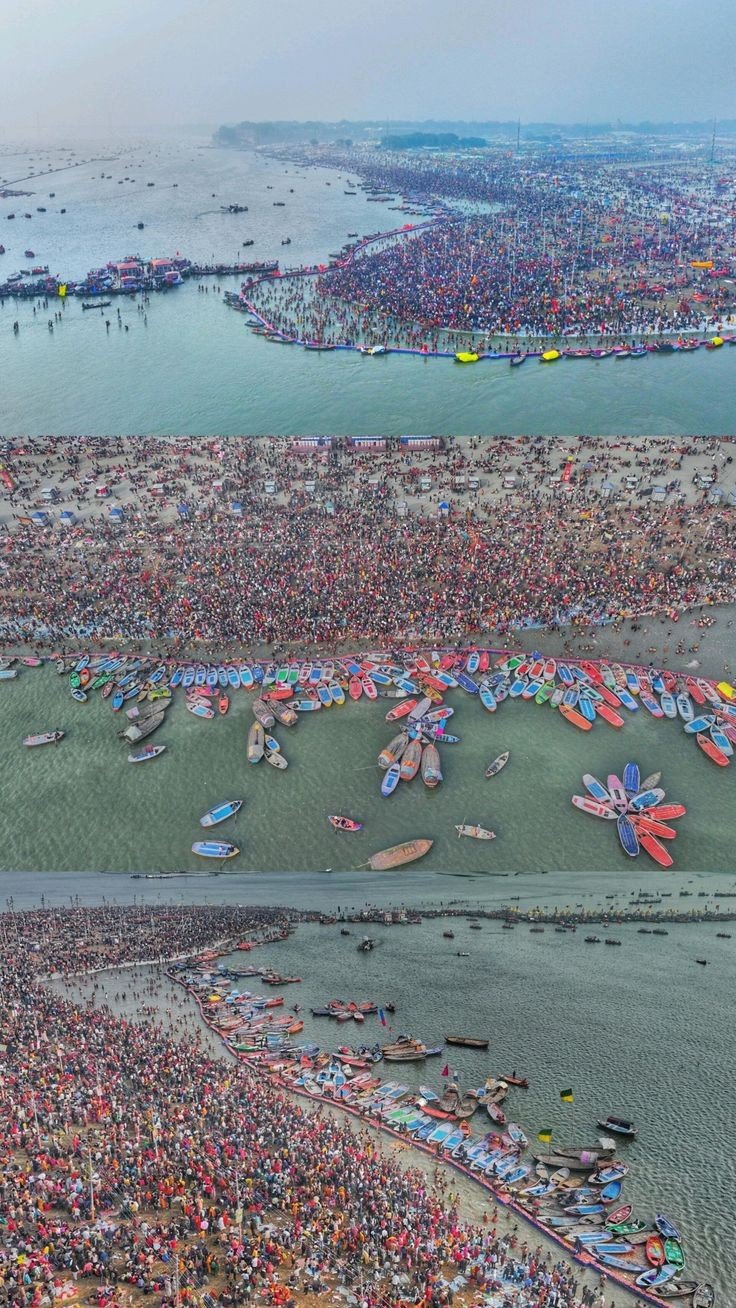Overview of the Maha Kumbh Rush
The Maha Kumbh Mela is a monumental religious festival that occurs every twelve years and is revered as one of the largest gatherings of human beings on the planet. This grand event attracts millions of devotees who converge from various parts of India and beyond to take part in sacred rituals, seek spiritual rejuvenation, and witness the communion of faith. Historically, the Mela has been an important spiritual pilgrimage for Hindus, symbolizing the gathering of pilgrims at the convergence of sacred rivers—the Ganges, Yamuna, and the mythical Saraswati. The Kumbh Mela holds immense significance, as it is believed that bathing in these waters during this auspicious period cleanses one of sins and grants Moksha, or liberation from the cycle of life and death.
Despite meticulous planning, the challenges of crowd control and vehicle movement during the Maha Kumbh often lead to unforeseen complications. Traffic snarls can emerge due to various factors including restricted roads, high-profile events, and adverse weather conditions. As seen in the recent events in Prayagraj, the convergence of these elements can result in extended delays and chaotic scenes, leading to thousands being trapped in traffic for prolonged periods. Understanding the context and sheer magnitude of the Maha Kumbh is crucial in comprehending the intensity of the traffic disruptions reported and the difficulties faced by authorities in managing this world-renowned event.
Details of the Traffic Snarl Incident
The recent traffic snarl in Prayagraj during the Maha Kumbh festival, which saw hundreds trapped for over 30 hours, serves as a stark illustration of the challenges posed by large-scale religious gatherings. The incident underscored the severity of traffic congestion during a time when millions flock to the city to participate in this revered event. Eyewitness accounts reveal that the scale of the congestion was unprecedented, with vehicles lining the roads as far as the eye could see, leaving many travelers helpless and frustrated.
Those caught in the traffic expressed a mix of disbelief and anxiety as they remained stationary for hours. Families were unable to access basic amenities, leading to distressing conditions within vehicles. With children and elderly passengers among those trapped, emotional tolls mounted as individuals faced hunger, fatigue, and mounting frustrations. The situation was further aggravated by the rapid onset of nightfall, which added an element of fear for many who were unprepared for such an extended duration of confinement.
The contributing factors to this chaotic scenario included multiple road closures, primarily attributed to construction work and security measures for the festival. Moreover, the sheer volume of attendees far exceeded anticipated numbers, leading to an overflow of vehicles that the existing infrastructure struggled to accommodate. The inadequacy of traffic management and contingency plans only exacerbated the problem, highlighting the need for improved urban planning and response strategies during large events. As locals and travelers alike grappled with this unfortunate situation, the incident serves as a reminder of the importance of preparedness in guaranteeing safety and efficiency amidst such enormous crowds.
Response from Authorities and Police
In the wake of the significant traffic congestion that gripped Prayagraj during the Maha Kumbh, local authorities implemented a series of measures aimed at alleviating the situation. Recognizing the severity of the traffic snarl, which left hundreds of vehicles and passengers stranded for over 30 hours, the police force was promptly mobilized to address the rapidly escalating crisis. Additional personnel were deployed to key intersections and bottlenecks to direct traffic and facilitate smoother movement. This strategy was fundamental in attempting to restore order amidst the chaos.
Moreover, city officials collaborated with transportation agencies to assess the situation continuously and deploy necessary resources. They established a command center focused on traffic management, which allowed for real-time assessments and adjustments to the deployment of officers and vehicles. In addition to personnel, the police utilized technological tools such as drones for aerial surveillance to identify trouble spots and optimize resource allocation effectively.
Communication also played a crucial role in the authorities’ response. Efforts were made to keep the public informed through various channels, including social media updates, press releases, and on-site announcements. These communications provided critical information regarding alternate routes and estimated timelines for resuming traffic flow, which was vital for those caught in the jam. Despite these efforts, challenges persisted. The volume of pilgrims attending the festivity far exceeded expectations, leading to unforeseen levels of congestion. While certain areas saw improved traffic conditions as a result of these interventions, others remained congested due to ongoing factors like road conditions and large crowds.
Though the response from authorities and the police included significant tactical measures, the complexity of managing such a large-scale event highlighted weaknesses in preparedness and infrastructure. As authorities reflect on this incident, it will be essential to evaluate the effectiveness of the employed strategies while also planning for better crowd management and transportation logistics in the future.
Consequences and Lessons Learned
The traffic chaos experienced during the Maha Kumbh in Prayagraj has cast a spotlight on the urgent need for enhanced infrastructure planning and effective traffic management protocols in the context of large-scale religious gatherings. With hundreds of individuals trapped for over 30 hours, the implications of this incident are multi-faceted, affecting not only the immediate participants but also the broader community. The prolonged congestion highlighted a fundamental challenge faced by local authorities in managing significant influxes of pilgrims, demonstrating a pressing need for improvements in the systems that handle the logistics of such historic events.
One of the critical lessons learned from this incident is the importance of constructive community relations. Adequate communication between government bodies, local businesses, and the diverse groups attending the event can foster a sense of collaboration. In turn, this cooperative framework can lead to more effective crisis management and a better overall experience for those involved. The stories shared by those affected by the traffic snarls illustrate the challenges they faced during the ordeal, shaping a narrative that underscores the necessity of prioritizing the pilgrims’ experiences alongside maintaining public safety.
The incident serves as a reminder of the critical role that comprehensive planning plays in the success of large public gatherings. Authorities must consider multiple aspects, including crowd control, road management, and emergency services, ensuring that these are in place well before the event starts. Furthermore, the integration of real-time data and technology could significantly enhance traffic management systems, allowing for swift responses to unexpected situations. The observations gleaned from this situation should inform future planning efforts, ensuring that lessons from the chaos at the Maha Kumbh contribute to a more organized and safe environment for future events.









Leave a Reply